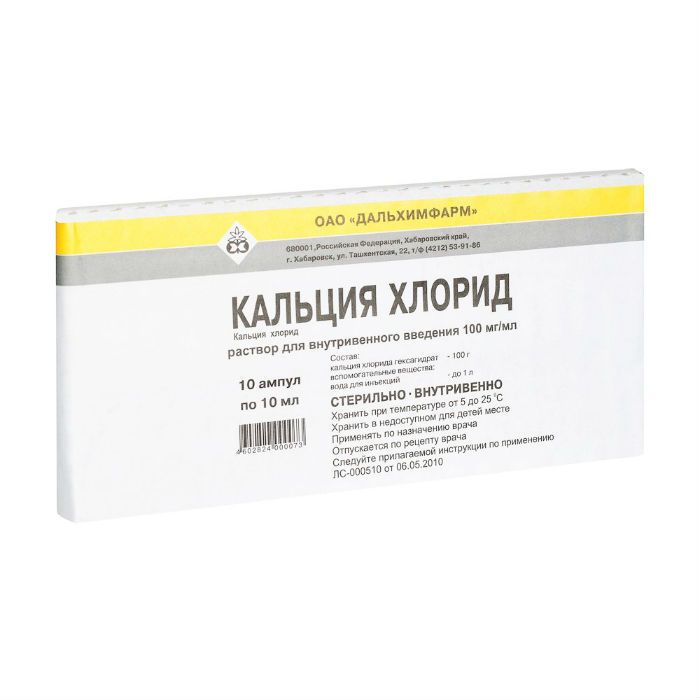calcium chloride | Calcium chloride ampoules 10% ampoules 10%, 10 ml, 10 pcs.
Special Price
$27
Regular Price
$34
In stock
SKU
BID512620
Release form
Solution for intravenous administration
Solution for intravenous administration
Release form
Solution for intravenous administration
Packing
10 ml - ampoules - packs of cardboard.
Pharmacological action
Calcium is a macrocell involved in the formation of bone tissue, the process of blood coagulation, is necessary to maintain stable cardiac activity, the processes of transmission of nerve impulses. It improves muscle contraction during muscular dystrophy, myasthenia gravis, and reduces vascular permeability. When iv is administered, calcium causes excitation of the sympathetic nervous system and increased adrenaline excretion of adrenaline has a moderate diuretic effect.
In the interaction of a solution of calcium chloride with magnesium salts, oxalic and fluoric acids, insoluble compounds are formed, which allows the use of calcium chloride solution as an antidote.
Indications
Bleeding of various etiologies and localization (pulmonary, gastrointestinal, nasal, uterine, etc.)
allergic diseases (serum sickness, urticaria, fever syndrome, itching, Quincke's edema)
nutritional dystrophic edema, spasmophilia
hypoparathyroidism,
hypercalcemia vascular disease, ),
weakness of labor,
poisoning with magnesium salts, oxalic and fluoric acids: paroxysmal myoplegia (hyperkalemic form).
Contraindications
Hypersensitivity,
hypercalcemia,
atherosclerosis,
tendency to thrombosis.
Special instructions
Do not enter subcutaneously or intramuscularly, tissue necrosis is possible (high concentrations of calcium chloride, starting from 5%, cause severe irritation of the vascular wall).
With the intravenous administration of calcium chloride, a sensation of heat appears first in the oral cavity, and then throughout the body (previously used to determine the speed of blood flow - the time between the moment of its introduction into the vein and the appearance of sensation of heat).
Composition of
1 ampoule (10 ml) contains calcium chloride 1 g
Dosage and administration
Slowly intravenously (6-8 drops / min), 5-15 ml of 10% solution, diluting before administration in 100-200 ml of 0.9% NaCl solution or 5% dextrose solution.
Side effects
When administered intravenously - a feeling of heat, flushing of the face, bradycardia, with rapid administration - ventricular fibrillation.
Local reactions (with intravenous administration) - pain and hyperemia along the vein.
Drug interaction
Calcium chloride is incompatible with salts of lead, silver, monovalent mercury due to the formation of insoluble chlorides of heavy metals and with sodium barbital, because in this case, poorly soluble calcium salt of barbital is formed.
Calcium chloride with simultaneous use reduces the effect of calcium channel blockers. Under the influence of colestyramine, calcium absorption from the gastrointestinal tract decreases. With simultaneous use with quinidine, it is possible to slow intraventricular conduction and increase the toxicity of quinidine. During treatment with cardiac glycosides, parenteral administration of calcium chloride is not recommended, due to the increased cardiotoxic effect.
Storage conditions
In a dry, dark place at a temperature of 18 to 25 РC. Keep out of the reach of children.
Term hodnosty
5 years
Deystvuyuschee substances
calcium
pharmacy s14lpf14 pf14 pf14 pf14f14 pf14pfff14 pf1414pfff14pfff14pfff14pf14pfff14pfff14pfff14pfff14pfff14pfff14pfff14pfff14pfff48 from
pharmacies Prescription
Dosage form
infusion solution
Indications
Skin itching, Urticaria, Quinc edema
Dalkhimpharm, Russia
Solution for intravenous administration
Packing
10 ml - ampoules - packs of cardboard.
Pharmacological action
Calcium is a macrocell involved in the formation of bone tissue, the process of blood coagulation, is necessary to maintain stable cardiac activity, the processes of transmission of nerve impulses. It improves muscle contraction during muscular dystrophy, myasthenia gravis, and reduces vascular permeability. When iv is administered, calcium causes excitation of the sympathetic nervous system and increased adrenaline excretion of adrenaline has a moderate diuretic effect.
In the interaction of a solution of calcium chloride with magnesium salts, oxalic and fluoric acids, insoluble compounds are formed, which allows the use of calcium chloride solution as an antidote.
Indications
Bleeding of various etiologies and localization (pulmonary, gastrointestinal, nasal, uterine, etc.)
allergic diseases (serum sickness, urticaria, fever syndrome, itching, Quincke's edema)
nutritional dystrophic edema, spasmophilia
hypoparathyroidism,
hypercalcemia vascular disease, ),
weakness of labor,
poisoning with magnesium salts, oxalic and fluoric acids: paroxysmal myoplegia (hyperkalemic form).
Contraindications
Hypersensitivity,
hypercalcemia,
atherosclerosis,
tendency to thrombosis.
Special instructions
Do not enter subcutaneously or intramuscularly, tissue necrosis is possible (high concentrations of calcium chloride, starting from 5%, cause severe irritation of the vascular wall).
With the intravenous administration of calcium chloride, a sensation of heat appears first in the oral cavity, and then throughout the body (previously used to determine the speed of blood flow - the time between the moment of its introduction into the vein and the appearance of sensation of heat).
Composition of
1 ampoule (10 ml) contains calcium chloride 1 g
Dosage and administration
Slowly intravenously (6-8 drops / min), 5-15 ml of 10% solution, diluting before administration in 100-200 ml of 0.9% NaCl solution or 5% dextrose solution.
Side effects
When administered intravenously - a feeling of heat, flushing of the face, bradycardia, with rapid administration - ventricular fibrillation.
Local reactions (with intravenous administration) - pain and hyperemia along the vein.
Drug interaction
Calcium chloride is incompatible with salts of lead, silver, monovalent mercury due to the formation of insoluble chlorides of heavy metals and with sodium barbital, because in this case, poorly soluble calcium salt of barbital is formed.
Calcium chloride with simultaneous use reduces the effect of calcium channel blockers. Under the influence of colestyramine, calcium absorption from the gastrointestinal tract decreases. With simultaneous use with quinidine, it is possible to slow intraventricular conduction and increase the toxicity of quinidine. During treatment with cardiac glycosides, parenteral administration of calcium chloride is not recommended, due to the increased cardiotoxic effect.
Storage conditions
In a dry, dark place at a temperature of 18 to 25 РC. Keep out of the reach of children.
Term hodnosty
5 years
Deystvuyuschee substances
calcium
pharmacy s14lpf14 pf14 pf14 pf14f14 pf14pfff14 pf1414pfff14pfff14pfff14pf14pfff14pfff14pfff14pfff14pfff14pfff14pfff14pfff14pfff48 from
pharmacies Prescription
Dosage form
infusion solution
Indications
Skin itching, Urticaria, Quinc edema
Dalkhimpharm, Russia
Submit your review to Earn 10 Reward Points click here to login
Write Your Own Review

